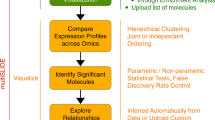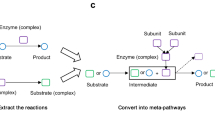Abstract
Biological Pathway Exchange (BioPAX) is a standard language to represent biological pathways at the molecular and cellular level and to facilitate the exchange of pathway data. The rapid growth of the volume of pathway data has spurred the development of databases and computational tools to aid interpretation; however, use of these data is hampered by the current fragmentation of pathway information across many databases with incompatible formats. BioPAX, which was created through a community process, solves this problem by making pathway data substantially easier to collect, index, interpret and share. BioPAX can represent metabolic and signaling pathways, molecular and genetic interactions and gene regulation networks. Using BioPAX, millions of interactions, organized into thousands of pathways, from many organisms are available from a growing number of databases. This large amount of pathway data in a computable form will support visualization, analysis and biological discovery.
This is a preview of subscription content, access via your institution
Access options
Subscribe to this journal
Receive 12 print issues and online access
$209.00 per year
only $17.42 per issue
Buy this article
- Purchase on Springer Link
- Instant access to full article PDF
Prices may be subject to local taxes which are calculated during checkout






Similar content being viewed by others
Change history
07 December 2010
In the version of this article initially published, the affiliation for Ken Fukuda should be Computational Biology Research Center, National Institute of Advanced Industrial Science and Technology, Tokyo, Japan. The error has been corrected in the HTML and PDF versions of the article.
10 April 2012
In the version of this article initially published, Oliver Reubenacker should have been spelled Oliver Ruebenacker. In addition, the location of the author's affiliation is Farmington, not Storrs. The errors have been corrected in the HTML and PDF versions of the article.
References
Gasteiger, E. et al. ExPASy: The proteomics server for in-depth protein knowledge and analysis. Nucleic Acids Res. 31, 3784–3788 (2003).
Nicholson, D.E. The evolution of the IUBMB-Nicholson maps. IUBMB Life 50, 341–344 (2000).
Demir, E. et al. PATIKA: an integrated visual environment for collaborative construction and analysis of cellular pathways. Bioinformatics 18, 996–1003 (2002).
Krull, M. et al. TRANSPATH: an information resource for storing and visualizing signaling pathways and their pathological aberrations. Nucleic Acids Res. 34, D546–D551 (2006).
Fukuda, K. & Takagi, T. Knowledge representation of signal transduction pathways. Bioinformatics 17, 829–837 (2001).
Davidson, E.H. et al. A genomic regulatory network for development. Science 295, 1669–1678 (2002).
Kohn, K.W. Molecular interaction map of the mammalian cell cycle control and DNA repair systems. Mol. Biol. Cell 10, 2703–2734 (1999).
Matthews, L. et al. Reactome knowledgebase of human biological pathways and processes. Nucleic Acids Res. 37, D619–D622 (2009).
Schaefer, C.F. et al. PID: the Pathway Interaction Database. Nucleic Acids Res. 37, D674–D679 (2009).
Bader, G.D. & Hogue, C.W. BIND—a data specification for storing and describing biomolecular interactions, molecular complexes and pathways. Bioinformatics 16, 465–477 (2000).
Kitano, H. A graphical notation for biochemical networks. BIOSILICO 1, 169–176 (2003).
Gama-Castro, S. et al. RegulonDB (version 6.0): gene regulation model of Escherichia coli K-12 beyond transcription, active (experimental) annotated promoters and Textpresso navigation. Nucleic Acids Res. 36, D120–D124 (2008).
Mi, H. et al. The PANTHER database of protein families, subfamilies, functions and pathways. Nucleic Acids Res. 33, D284–D288 (2005).
Keseler, I.M. et al. EcoCyc: a comprehensive view of Escherichia coli biology. Nucleic Acids Res. 37, D464–D470 (2009).
Caspi, R. et al. The MetaCyc database of metabolic pathways and enzymes and the BioCyc collection of pathway/genome databases. Nucleic Acids Res. 38, D473–D479 (2010).
Kanehisa, M., Goto, S., Kawashima, S., Okuno, Y. & Hattori, M. The KEGG resource for deciphering the genome. Nucleic Acids Res. 32 Database issue, D277–280 (2004).
Bader, G.D., Cary, M.P. & Sander, C. Pathguide: a pathway resource list. Nucleic Acids Res. 34, D504–D506 (2006).
Huang, W., Sherman, B.T. & Lempicki, R.A. Bioinformatics enrichment tools: paths toward the comprehensive functional analysis of large gene lists. Nucleic Acids Res. 37, 1–13 (2009).
Chuang, H.Y., Lee, E., Liu, Y.T., Lee, D. & Ideker, T. Network-based classification of breast cancer metastasis. Mol. Syst. Biol. 3, 140 (2007).
Shannon, P. et al. Cytoscape: a software environment for integrated models of biomolecular interaction networks. Genome Res. 13, 2498–2504 (2003).
Karp, P.D. et al. Pathway Tools version 13.0: integrated software for pathway/genome informatics and systems biology. Brief. Bioinform. 11, 40–79 (2010).
Hu, Z. et al. VisANT 3.0: new modules for pathway visualization, editing, prediction and construction. Nucleic Acids Res. 35, W625–W632 (2007).
Hoffmann, R. et al. Text mining for metabolic pathways, signaling cascades, and protein networks. Sci. STKE 2005, pe21 (2005).
Racunas, S.A., Shah, N.H., Albert, I. & Fedoroff, N.V. HyBrow: a prototype system for computer-aided hypothesis evaluation. Bioinformatics 20 Suppl 1, i257–i264 (2004).
Cary, M.P., Bader, G.D. & Sander, C. Pathway information for systems biology. FEBS Lett. 579, 1815–1820 (2005).
Vivanco, I. & Sawyers, C.L. The phosphatidylinositol 3-Kinase AKT pathway in human cancer. Nat. Rev. Cancer 2, 489–501 (2002).
Koh, G., Teong, H.F., Clement, M.V., Hsu, D. & Thiagarajan, P.S. A decompositional approach to parameter estimation in pathway modeling: a case study of the Akt and MAPK pathways and their crosstalk. Bioinformatics 22, e271–e280 (2006).
Karp, P.D. An ontology for biological function based on molecular interactions. Bioinformatics 16, 269–285 (2000).
Joshi-Tope, G. et al. Reactome: a knowledgebase of biological pathways. Nucleic Acids Res. 33 Database issue, D428–D432 (2005).
Mi, H., Guo, N., Kejariwal, A. & Thomas, P.D. PANTHER version 6: protein sequence and function evolution data with expanded representation of biological pathways. Nucleic Acids Res. 35, D247–D252 (2007).
Demir, E. et al. An ontology for collaborative construction and analysis of cellular pathways. Bioinformatics 20, 349–356 (2004).
Bader, G.D., Betel, D. & Hogue, C.W. BIND: the Biomolecular Interaction Network Database. Nucleic Acids Res. 31, 248–250 (2003).
Salwinski, L. et al. The Database of Interacting Proteins: 2004 update. Nucleic Acids Res. 32, D449–D451 (2004).
Chatr-aryamontri, A. et al. MINT: the Molecular INTeraction database. Nucleic Acids Res. 35, D572–D574 (2007).
Kerrien, S. et al. IntAct—open source resource for molecular interaction data. Nucleic Acids Res. 35, D561–D565 (2007).
Stark, C. et al. BioGRID: a general repository for interaction datasets. Nucleic Acids Res. 34, D535–D539 (2006).
Matys, V. et al. TRANSFAC(R) and its module TRANSCompel(R): transcriptional gene regulation in eukaryotes. Nucleic Acids Res. 34, D108–D110 (2006).
Kerrien, S. et al. Broadening the horizon—level 2.5 of the HUPO-PSI format for molecular interactions. BMC Biol. 5, 44 (2007).
Costanzo, M. et al. The genetic landscape of a cell. Science 327, 425–431 (2010).
Ashburner, M. et al. Gene ontology: tool for the unification of biology. The Gene Ontology Consortium. Nat. Genet. 25, 25–29 (2000).
Eilbeck, K. et al. The Sequence Ontology: a tool for the unification of genome annotations. Genome Biol. 6, R44 (2005).
Yamamoto, S., Asanuma, T., Takagi, T. & Fukuda, K.I. The molecule role ontology: an ontology for annotation of signal transduction pathway molecules in the scientific literature. Comp. Funct. Genomics 5, 528–536 (2004).
Cerami, E.G., Bader, G.D., Gross, B.E. & Sander, C. cPath: open source software for collecting, storing, and querying biological pathways. BMC Bioinformatics 7, 497 (2006).
Cline, M.S. et al. Integration of biological networks and gene expression data using Cytoscape. Nat. Protoc. 2, 2366–2382 (2007).
Efroni, S., Carmel, L., Schaefer, C.G. & Buetow, K.H. Superposition of transcriptional behaviors determines gene state. PLoS ONE 3, e2901 (2008).
Ideker, T., Ozier, O., Schwikowski, B. & Siegel, A.F. Discovering regulatory and signalling circuits in molecular interaction networks. Bioinformatics 18 Suppl 1, S233–S240 (2002).
Cancer Genome Atlas Research Network. Comprehensive genomic characterization defines human glioblastoma genes and core pathways. Nature 455, 1061–1068 (2008).
Wu, G., Feng, X. & Stein, L. A human functional protein interaction network and its application to cancer data analysis. Genome Biol. 11, R53 (2010).
Pinto, D. et al. Functional impact of global rare copy number variation in autism spectrum disorders. Nature 466, 368–372 (2010).
Isserlin, R. et al. Pathway analysis of dilated cardiomyopathy using global proteomic profiling and enrichment maps. Proteomics 10, 1316–1327 (2010).
Moraru, I.I. et al. Virtual Cell modelling and simulation software environment. IET Syst. Biol. 2, 352–362 (2008).
Hlavacek, W.S. et al. Rules for modeling signal-transduction systems. Sci. STKE 2006, re6 (2006).
Pico, A.R. et al. WikiPathways: pathway editing for the people. PLoS Biol. 6, e184 (2008).
Kitano, H., Funahashi, A., Matsuoka, Y. & Oda, K. Using process diagrams for the graphical representation of biological networks. Nat. Biotechnol. 23, 961–966 (2005).
Lloyd, C.M., Halstead, M.D. & Nielsen, P.F. CellML: its future, present and past. Prog. Biophys. Mol. Biol. 85, 433–450 (2004).
Hucka, M. et al. The systems biology markup language (SBML): a medium for representation and exchange of biochemical network models. Bioinformatics 19, 524–531 (2003).
Sauro, H.M. et al. Next generation simulation tools: the Systems Biology Workbench and BioSPICE integration. OMICS 7, 355–372 (2003).
Hermjakob, H. et al. The HUPO PSI's molecular interaction format—a community standard for the representation of protein interaction data. Nat. Biotechnol. 22, 177–183 (2004).
Racunas, S.A., Shah, N.H. & Fedoroff, N.V. A case study in pathway knowledgebase verification. BMC Bioinformatics 7, 196 (2006).
Laibe, C. & Le Novere, N. MIRIAM Resources: tools to generate and resolve robust cross-references in Systems Biology. BMC Syst. Biol. 1, 58 (2007).
Berners-Lee, T. & Hendler, J. Publishing on the semantic web. Nature 410, 1023–1024 (2001).
Le Novere, N. et al. The Systems Biology Graphical Notation. Nat. Biotechnol. 27, 735–741 (2009).
Knublauch, H., Fergerson, R.W., Noy, N.F. & Musen, M.A. The Protégé OWL Plugin: An Open Development Environment for Semantic Web Applications. in The Semantic Web–ISWC 2004: Third International Semantic Web Conference, Hiroshima, Japan, November 7-11, 2004: Proceedings (eds. McIlraith, S.A., Dimitris Plexousakis, D. & van Harmelen, F.) 229—243 (Springer, 2004).
Sowa, J.F. Knowledge Representation: Logical, Philosophical, and Computational Foundations (Brooks/Cole, 2000).
Wheeler, D.L. et al. Database resources of the National Center for Biotechnology Information. Nucleic Acids Res. 35, D5–D12 (2007).
Acknowledgements
Funded by the US Department of Energy workshop grant DE-FG02-04ER63931, the caBIG program, the US National Institute of General Medical Sciences workshop grant 1R13GM076939, grant P41HG004118 from the US National Human Genome Research Institute and Genome Canada through the Ontario Genomics Institute (2007-OGI-TD-05) and US National Institutes of Health grant R01GM071962-07. Thanks to many people who contributed to discussions on BioPAX mailing lists, at conferences and at BioPAX workshops, especially A. Ruttenberg and J. Rees.
Author information
Authors and Affiliations
Contributions
All authors helped develop the BioPAX language, ontology, documentation and examples by participating in workshops or on mailing lists and/or provided data in BioPAX format and/or wrote software that supports BioPAX. See Supplementary Table 5 for a full list of author contributions.
Corresponding author
Ethics declarations
Competing interests
The authors declare no competing financial interests.
Supplementary information
Supplementary Text and Figures
Supplementary Tables 1–5 and Supplementary Fig. 1 (PDF 767 kb)
Rights and permissions
About this article
Cite this article
Demir, E., Cary, M., Paley, S. et al. The BioPAX community standard for pathway data sharing. Nat Biotechnol 28, 935–942 (2010). https://doi.org/10.1038/nbt.1666
Published:
Issue Date:
DOI: https://doi.org/10.1038/nbt.1666
This article is cited by
-
Transomics2cytoscape: an automated software for interpretable 2.5-dimensional visualization of trans-omic networks
npj Systems Biology and Applications (2024)
-
Adapting modeling and simulation credibility standards to computational systems biology
Journal of Translational Medicine (2023)
-
FAIRification of health-related data using semantic web technologies in the Swiss Personalized Health Network
Scientific Data (2023)
-
A molecular network map of orexin-orexin receptor signaling system
Journal of Cell Communication and Signaling (2023)
-
Heuristic shortest hyperpaths in cell signaling hypergraphs
Algorithms for Molecular Biology (2022)



